超低ノイズ単一周波数レーザーシステム、ベンチトップ型、1550 nm
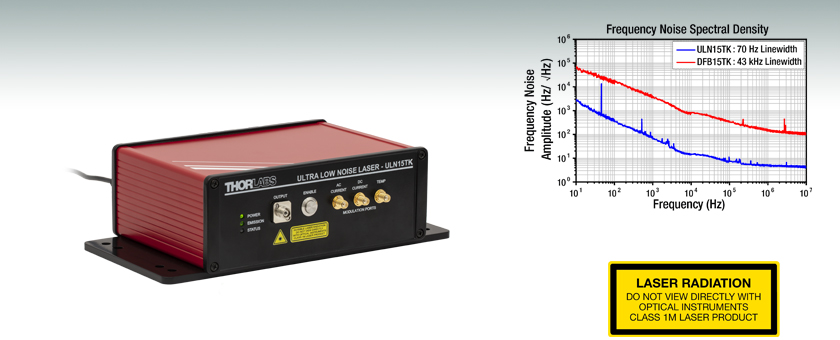
- High-Power, Turnkey, Single-Frequency Laser Systems at 1550 nm
- Low-Noise Drive Electronics to Minimize RIN and Linewidth
- 20 MHz Current Modulation Bandwidth
- Linewidths as Low as 100 Hz Available
Narrow-Linewidth, Low-Noise Laser Systems, 1550 nm
The frequency noise spectral density gives a Lorentzian linewidth of 70 Hz for the ULN15TK and 43 kHz for the DFB15TK.
US Patents: 10193306, 10483718,
10476233, and 10454248

Please Wait
| Key Specification Comparison | ||
|---|---|---|
| Item # | ULN15TK | DFB15TK |
| Typical Linewidth | 100 Hz | 50 kHz |
| Typical RIN | -160 dBc/Hz | -150 dBc/Hz |
| Mode-Hop-Free Single-Frequency Operating Current Region |
Discontinuousa | Continuousb |
| Temperature Tuning Range | 0.32 nmc | 2 nmd |
| AC Current Modulation Depth | ±10 mA | ±100 mA |
| DC Current Modulation Depth | ±10 mA | ±10 mA |
Applications
- Optical Reference Laser
- LIDAR/LADAR
- Fiber Optic Sensing
- Quantum Optics
- Atomic Clocks
- Rubidium Cooling
Features
- High-Power Turnkey Single-Frequency Laser Systems in the C-Band
- Ultra-Low-Noise (ULN), Narrow-Linewidth Laser System:
- 100 Hz Typical Linewidth, 70 dB typical SMSR
- RIN of -160 dBc/Hz
- Discontinuous Mode-Hop-Free Regions 20 mA to 50 mA Wide
- Temperature Tuning Range of 0.32 nm with Simultaneous Current Tuning
- Distributed Feedback (DFB) Laser System:
- 50 kHz Typical Linewidth, 50 dB Typical Side-Mode Suppression Ratio (SMSR)
- Relative Intensity Noise (RIN) of -150 dBc/Hz
- Continuous Mode-Hop-Free Operating Current Region
- Temperature Tuning Range of 2 nm
- Low-Noise Drive Electronics to Minimize RIN and Linewidth
- Analog Modulation Inputs for DC Current, AC Current, and Laser Temperature
- Integrated Isolator with to Minimize Effects of Back-Reflected Light
- Remote Operation and Set-Point Adjustment with Command-Line Interface via USB 2.0
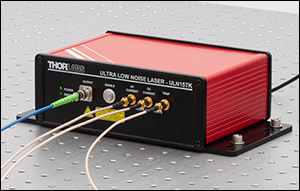
Click to Enlarge
The ULN15TK laser can be mounted to an optical table using four 1/4"-20 cap screws. The ULN15TK is pictured with a P3-1550PM-FC-5 PM fiber patch cable and three CA2912 SMA cables, which are connected to the optical output and analog modulation ports, respectively.
Thorlabs' single-frequency, turnkey, low-noise laser systems are ready-to-use laser systems that integrate our ULN15PC or DFB1550P diodes with a low-noise driver and temperature stabilization inside of a benchtop housing. To minimize the laser linewidth and relative intensity noise (RIN), these lasers includes drive electronics that are designed to minimize the curent noise. An isolator is integrated at the output of the lasers to minimize the impact of any back-reflected light on the lasers.
The ULN15TK is an ultra-low-noise (ULN) laser system based on a hybrid external-cavity semiconductor laser employing a fiber Bragg grating (FBG) for feedback to the laser cavity. This patented design enables exceptionally narrow Lorentzian linewidths of 100 Hz and record low RIN below -160 dBc/Hz. When factory-set for optimized performance, this laser offers typical optical output powers of 120 mW with an SMSR of 70 dB. As a result of this unique design, the mode-hop-free single-frequency regions are not continuous as the laser current is adjusted, typically limited to 20 mA to 50 mA wide current regions. The temperature of the laser case is stabilized through a third temperature stabilization circuit to provide long-term power and wavelength stability when the system is used in standard laboratory environments.
The DFB15TK is based on a distributed feedback (DFB) cavity on the laser chip, providing single-frequency emission with typical relative intensity noise (RIN) of -150 dBc/Hz and typical linewidths of 50 kHz. Factory-set for optimized performance, this laser offers a minimum output power of 100 mW with a side-mode suppression ratio (SMSR) of 50 dB. This design allows for a broad, mode-hop-free, single-frequency operation range (350 mA to 1000 mA). The DFB15TK laser system can also be tuned by adjusting the current or the temperature of the laser chip, with a mode-hop-free temperature tuning range of up to 2 nm.
These lasers are designed with laser frequency locking applications in mind. The systems come equipped with two analog current modulation ports (DC and AC coupled) and an analog temperature modulation port. These modulation inputs can be used to lock the laser frequencies to optical cavities or referenced using servo electronics in order to build stable laser systems.
The optical outputs of these lasers are fiber-coupled via FC/APC bulkhead (2.0 mm narrow key) output connectors. For best performance, we recommend connecting our PM FC/APC fiber patch cables that contain PM1550-XP fiber, such as the P3-1550PM-FC-1 patch cable. Note that the polarization axis is aligned with the narrow key of the bulkhead connector.
The systems are powered by a 12 VDC, 4 A input. A DS12 power supply is provided with each laser; see the Shipping List tab for a complete list of items included with the device.
Single-Frequency Operation and Wavelength Tuning
Factory-set for single-frequency operation, these laser have a preset drive current and temperature. When the laser is enabled using the push-button switch on the front panel (see Front & Back Panels tab), the laser operates at the preset current level. Each laser is shipped with a test data sheet taken at the preset operating conditions; click here for a sample data sheet. The user can adjust the operating current either by sending a command through USB communication (see Remote Operation below) or by applying small modulation to the current through one of the modulation ports on the front panel of the system (see Analog Modulation below). Adjusting the operating current results in both a change in the output power but also a change in the laser wavelength. In addition to the operating current, the laser chip or FBG temperature is also adjustable either through the command-line interface (USB) or the front-panel modulation port. The temperature changes are primarily useful for tuning the laser wavelength while maintaining a relatively constant output power. See the Graphs and Specs tabs for more information on current and temperature tuning of these lasers.
Analog Modulation
By controlling the laser drive current or temperature, the laser wavelength can be tuned free of mode-hopping within a small range around its set-point. Three analog modulation ports (SMA Female) are included on the front panel (see the Front & Back Panels tab). Two of the ports allow the laser current to be modulated by ±10 mA around the current set point: of these, the port labelled "AC Current" can support modulation frequencies up to 20 MHz, and the port labelled "DC Current" accepts frequencies from DC to 5 MHz. The third port, which is labelled "Temp", controls the FBG temperature (ULN15TK) or chip temperature (DFB15TK) and accepts modulation frequencies from DC to 1 Hz. To see how the laser wavelength can be tuned around its set-point, please see the wavelength tuning plots provided in the Graphs tab.
Each modulation port accepts a -5 V to 5 V input signal. To convert the modulation voltage into a current or temperature change, see the Specs tab.
Remote Operation
Remote operation is also possible by connecting the laser to a PC (not included) via the USB port on the back of the unit and using a command line interface. In addition to basic functions such as turning the laser on and off or reading status indicators, the command line enables the user to modify the laser operating set-points. The full list of commands can be found in the laser manual. A USB-AB-72 USB 2.0 Type-A to Mini-B Cable is included with each device.
Adjusting the laser parameters (operating current and temperature) can be used for tuning the laser power or wavelength. Typical performance plots that demonstrate the laser's center wavelength tuning and the single-mode operating regions can be found on the Graphs tab. Please note that specific performance data is provided on the datasheet shipped with each device.
A 9-Pin female D-Sub connector is also included on the back panel of the system for RS-485 communication protocol. Please refer to the Pin Diagrams tab for the pin assignment of the connector.
Mounting
For mounting to an optical table, the compact housing of this benchtop ULN laser features four clearance holes each for M6 or 1/4-20" cap screws.
| Item # | ULN15TK | DFB15TK |
|---|---|---|
| Laser Specificationsa | ||
| Center Wavelengthb | 1550 nm ± 15 nm | 1555 nm ± 10 nm |
| Output Powerc | > 90 mW (Typ. 120 mW) | ≥100 mW |
| Linewidthd | < 250 Hz (Typ. 100 Hz) | < 100 kHz (Typ. 50 kHz) |
| Relative Intensity Noise (RIN)e | -160 dBc/Hz | -150 dBc/Hz |
| Side-Mode Suppression Ratio (SMSR) | > 60 dB (Typ. 70 dB) | > 30 dB (Typ. 50 dB) |
| Polarization Extinction Ratio (PER) | > 18 dB | 23 dB |
| Output Isolation | > 25 dB | 50 dB |
| Mode-Hop-Free Operating Current | - | 350 mA - 1000 mA |
| Mode-Hop-Free Power Range | - | 40 mW - 100 mW |
| Slope Efficiency | - | 0.15 W/A |
| Threshold Current | 50 mA | 50 mA |
| Current Tuning Coefficient | 0.25 pm/mA | 0.006 nm/mA |
| FBG Temperature Tuning Coefficient | 8 pm/°C | - |
| FBG Temperature Tuning Range | 10 °C - 50 °C | - |
| Laser Chip Tuning Coefficient | - | 0.10 nm/°C |
| Laser Chip Temperature Tuning Range | - | 15 °C - 35 °C |
| Fiber Specifications | ||
| Output Fiber Typef | Corning® PM15-U25D | PM1550 |
| Output Fiber Connectors | FC/APC Compatible, 2.0 mm Narrow Key | |
| External Modulation Specifications | ||
| AC Voltage to Current Conversion Rate | 2 mA/V | 20 mA/V |
| DC Voltage to Current Conversion Rate | 2 mA/V | |
| Voltage to Temperature Conversion Rate | Firmware Adjustable (Default = 0.2 °C/V) | |
| Input Voltage Range (All Ports) | -5 V to 5 V | |
| Input Impedance (All Ports) | 1 kΩ | |
| AC Current Modulation Frequency Rangeg | 2 kHz to 20 MHz | |
| DC Current Modulation Frequency Rangeg | DC to 5 MHz | |
| Temperature Modulation Frequency Range | DC to 1 Hz | |
| Absolute Maximum Ratings | |
|---|---|
| Absolute Maximum Output Power | 145 mW |
| Operating Temperature | 15 °C to 30 °C |
| Storage Temperature | -10 °C to 40 °C |
| General Specifications | |
|---|---|
| Input Voltage | 12 V (from DS12 Power Supply) |
| Input Power | 20 W (Max) |
| Dimensions (W x D x H) | 10.00" x 5.31" x 2.93" (254.0 mm x 135.0 mm x 74.4 mm) |
| Weight | 4.7 lbs (2.1 kg) |
The plots below represent the relative intensity noise (RIN) and frequency noise for the low-noise, single-frequency laser systems.
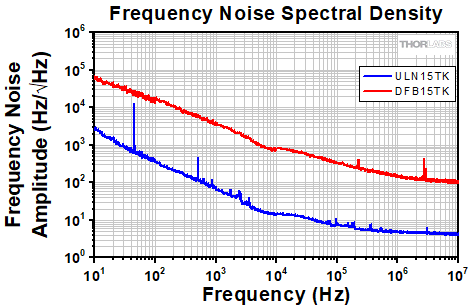
Click to Enlarge
Example frequency noise data for the ULN15TK and DFB15TK laser systems operated at the factory-set conditions.
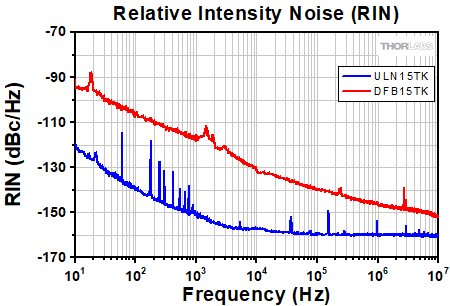
Click to Enlarge
The typical low-frequency relative intensity noise (RIN) for a ULN15TK and DFB15TK laser system operated at the factory-set conditions.
The plots below represent the typical performance of the ULN15TK ultra-low-noise laser system. Specific performance data is provided on the datasheet shipped with each device; click here for a sample data sheet.
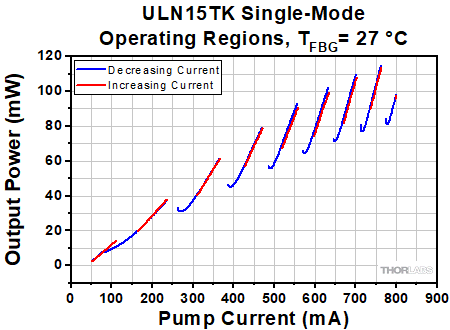
Click to Enlarge
Click Here for Data
The typical single mode operating regions for a ULN15TK laser system operated at a Fiber Bragg Grating temperature (TFBG) of 27 °C. Multimode regions have been removed.
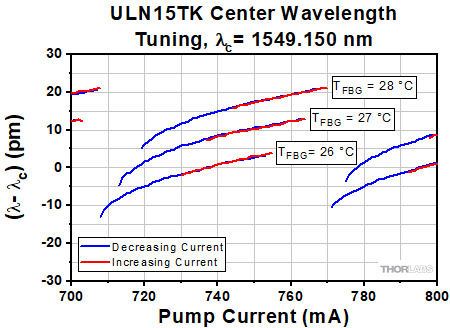
Click to Enlarge
Click Here for Data
The center wavelength (λc) tuning with changes in the pump current and Fiber Bragg Grating temperature (TFBG). Multimode regions have been removed.
The plots below represent the typical performance of the DFB15TK low-noise laser system. Specific performance data is provided on the datasheet shipped with each device; click here for a sample data sheet.
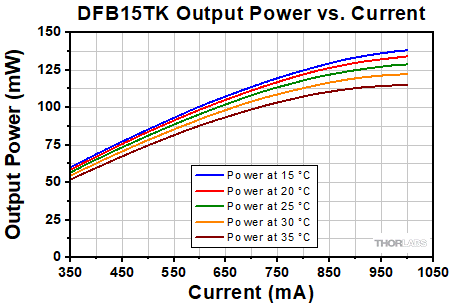
Click to Enlarge
Click Here for Data
Example output power vs. current data for a DFB15TK laser system operated at factory-set conditions.
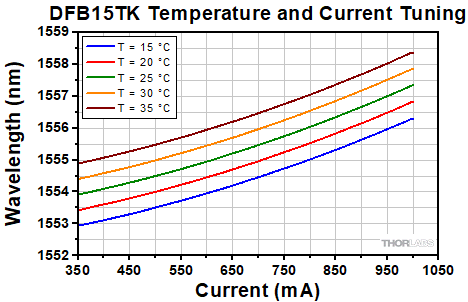
Click to Enlarge
Click Here for Data
Example temperature and current tuning for a DFB15TK laser system operated at the factory-set conditions.
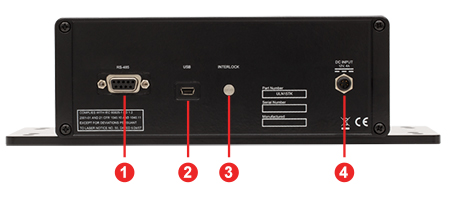
Click to Enlarge
ULN15TK Turnkey ULN Laser Back Panel
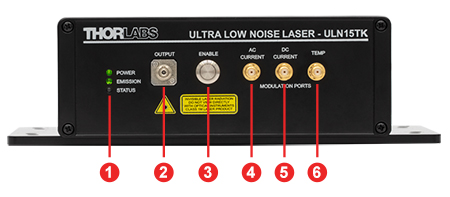
Click to Enlarge
ULN15TK Turnkey ULN Laser Front Panel
| Front Panel | |
|---|---|
| Call Out | Description |
| 1 | Status Indicator LEDs |
| 2 | Laser Output Port (FC/APC, 2.0 mm Narrow Key, PM Fiber Output) |
| 3 | Laser Enable Push-Button Switch |
| 4 | AC Current Modulation Input (SMA Female) |
| 5 | DC Current Modulation Input (SMA Female) |
| 6 | Temperature Control Modulation Input (SMA Female) |
| Back Panel | |
|---|---|
| Call Out | Description |
| 1 | RS-485 Communication (DB-9 Female) |
| 2 | USB Communication (USB Mini-B) |
| 3 | Remote Interlock Pin (2.5 mm Mono Phono Female) |
| 4 | DC Input (M8 Connector for the DS12 Power Supply) |
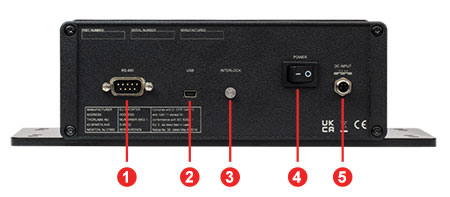
Click to Enlarge
DFB15TK Turnkey DFB Laser Back Panel
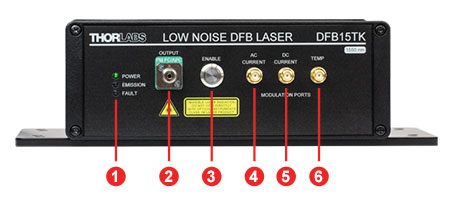
Click to Enlarge
DFB15TK Turnkey DFB Laser Front Panel
| Front Panel | |
|---|---|
| Call Out | Description |
| 1 | Status Indicator LEDs |
| 2 | Laser Output Port (FC/APC, 2.0 mm Narrow Key, PM Fiber Output) |
| 3 | Laser Enable Push-Button Switch |
| 4 | AC Current Modulation Input (SMA Female) |
| 5 | DC Current Modulation Input (SMA Female) |
| 6 | Temperature Control Modulation Input (SMA Female) |
| Back Panel | |
|---|---|
| Call Out | Description |
| 1 | RS-485 Communication (DB-9 Male) |
| 2 | USB Communication (USB Mini-B) |
| 3 | Remote Interlock Pin (2.5 mm Mono Phono Female) |
| 4 | Power Switch |
| 5 | DC Input (M8 Connector for the DS12 Power Supply) |
ULN15TK Pin Diagrams
USB 2.0 Communication
USB Mini-B
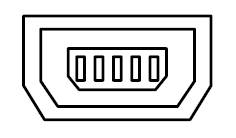
Input for Analog Modulation
SMA Female
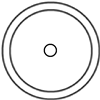
Input Voltage: -5 V to 5 V
Input Impedance: 1 kΩ
AC Current Modulation Frequency Range: 2 kHz to 20 MHz*
DC Current Modulation Frequency Range: DC to 5 MHz*
*The specified bandwidth refers to the 3 dB electrical bandwidth of the modulation circuits. The laser response has a slow roll-off for frequencies above 1 MHz.
RS-485 Communication
9-Pin Female D-Sub Connector 
| Pin Assignment | |
|---|---|
| Pin | Output Signal |
| 1 | RS-485 Half-Duplex T/R+ |
| 2 | RS-485 Half-Duplex T/R- |
| 3 | Not Connected |
| 4 | Not Connected |
| 5 | Ground |
| 6 | Not Connected |
| 7 | Ground |
| 8a | Do Not Connect |
| 9a | Do Not Connect |
DFB15TK Pin Diagrams
USB 2.0 Communication
USB Mini-B

Input for Analog Modulation
SMA Female

Input Voltage: -5 V to 5 V
Input Impedance: 1 kΩ
AC Current Modulation Frequency Range: 2 kHz to 20 MHz*
DC Current Modulation Frequency Range: DC to 5 MHz*
*The specified bandwidth refers to the 3 dB electrical bandwidth of the modulation circuits. The laser response has a slow roll-off for frequencies above 1 MHz.
RS-485 Communication
9-Pin Male D-Sub Connector 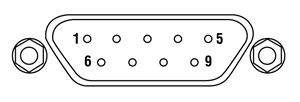
| Pin Assignment | |
|---|---|
| Pin | Output Signal |
| 1 | RS-485 Half-Duplex T/R+ |
| 2 | RS-485 Half-Duplex T/R- |
| 3 | Not Connected |
| 4 | Not Connected |
| 5 | Ground |
| 6 | Not Connected |
| 7 | Ground |
| 8a | Do Not Connect |
| 9a | Do Not Connect |
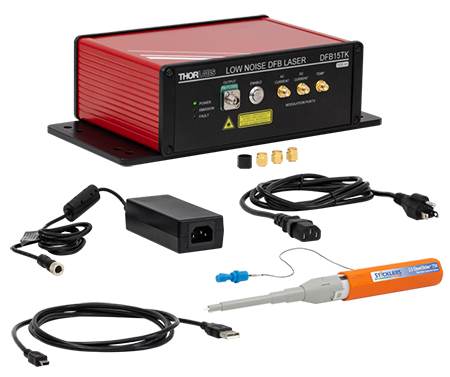
Click to Enlarge
DFB15TK Laser System and Accessories
The ULN15TK Turnkey Ultra-Low-Noise (ULN) Laser System ships with the following components:
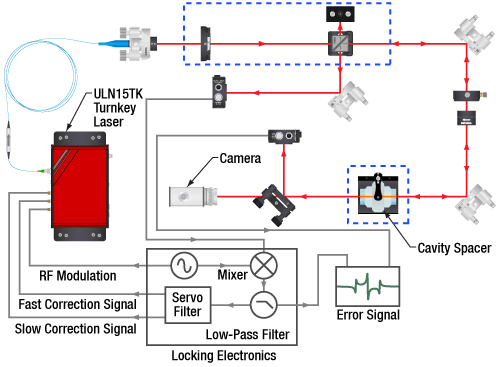
Click for Details
レーザ安定化用の実験セットアップ
レーザ安定化
ターンキー式超低ノイズレーザULN15TKは、並外れた光スペクトル純度を有し、セットアップの必要がほとんどないため到着後すぐにお使いいただける構成になっています。ただし、光学時計や高分解能分光法などの要件の厳しい用途では、技術的なノイズやドリフトをさらに抑制するために、アクティブな電子フィードバックが必要になる場合があります。このターンキー式レーザには複数の高帯域幅アナログ変調ポートがあり、光共振器や原子/分子遷移などの外部の光基準に同期させる際に役立ちます。
当社では低損失のスーパーミラーを単独、またはカスタム仕様のリファレンスキャビティとしてご提供しています。右の図では、超低膨張(ULE)ガラススペーサに取り付けられた結晶スーパーミラーXM12R8とXM12P8で構成されるリファレンスキャビティにレーザULN15TKをロックするために、PDH(Pound-Drever-Hall)ロック方式を使用する方法の一例を示しています。RF変調入力により、外部の光変調器なしでPDH側波帯を簡単に生成できます。キャビティからの反射信号の復調により、光共振器との共振を維持するためにサーボフィルタで処理できるエラー信号が生成されます。このターンキー式レーザには、高速変動を補正する高帯域幅のDC結合電流変調ポートと、低速ドリフトを補正する広い範囲の低速温度変調ポートがあります。
| Key Specification Comparison | ||
|---|---|---|
| Item # | ULN15TK | DFB15TK |
| Typical Linewidth | 100 Hz | 50 kHz |
| Typical RIN | -160 dBc/Hz | -150 dBc/Hz |
| Mode-Hop-Free Single-Frequency Operating Current Region |
Discontinuousa |
Continuousb |
| Temperature Tuning Range | 0.32 nmc | 2 nmd |
| AC Current Modulation Depth | ±10 mA | ±100 mA |
| DC Current Modulation Depth | ±10 mA | ±10 mA |
The ULN15TK and DFB15TK are both single-frequency turnkey laser systems that are equipped with low-noise drive electronics. Both systems enable laser frequency modulation, which can be utilized along with locking electronics to lock the laser frequency to optical references or cavities.
The ultra-low-noise (ULN) system provides exceptionally narrow Lorentzian linewidth (typ. 100 Hz) and record low RIN (typ. -160 dBc/Hz) for applications that require such demanding noise performance. The ULN design is based on a hybrid external-cavity semiconductor laser employing a fiber Bragg grating (FBG) for feedback to the laser cavity. As a result, the mode-hop-free single-frequency regions of the ULN are not continuous as the laser current is adjusted. Each mode-hop-free single-frequency region is typically limited to 20 mA to 50 mA of drive current (see Graphs tab for performance plots of the ULN15TK). The ULN wavelength can be adjusted via both current adjustment of the chip and temperature adjustment of the FBG. The broadest tuning range for a ULN is achieved via FBG temperature adjustment and is typically limited to <0.4 nm (with FBG temperature adjusted by approximately 40 °C). In order to maintain single-frequency operation as the temperature is tuned over a broad range, the laser current needs to be adjusted simultaneously.
The DFB15TK design is based on a distributed feedback (DFB) cavity on the laser chip. This design allows a much broader mode-hop-free single-frequency operation range (350 mA to 1000 mA). The Lorentzian linewidth of the laser is broader than the ULN with a typical value of 50 kHz, and the RIN is also higher with a typical value of -150 dBc/Hz. The linewidth and RIN of the DFB15TK are still exceptionally low for this laser type thanks to the low-noise electronics and turnkey system. The DFB can also be tuned in both ways by adjusting the current or the temperature of the laser chip. The broadest tuning can be achieved by adjusting the chip temperature and a typical tuning up to 2 nm (with chip temperature adjusted by 20 °C) can be achieved. Unlike the ULN, the DFB stays in single-frequency mode as the temperature is tuned without the need to simultaneously adjust the current.
In summary, the ULN offers superior phase noise (linewidth) and intensity noise (RIN) performance, while the DFB offers broader tuning and a broader mode-hop-free single-frequency operating region. The DFB is also a lower cost alternative to the ULN for applications that are less demanding on noise or linewidth.
| Posted Comments: | |
Oliver Dölle
(posted 2023-04-03 14:53:43.483) Hi,
we will integrate the ULN15TK in our Laser stabilization system. Therefore I need the dimensions of the ULN15TK. Can you send me any technical drawings? Perhaps you have even a CAD model (step or iges)?
That would help me a lot!
Thank you,
Oliver Dölle, zeptocision GmbH cdolbashian
(posted 2023-04-03 02:47:49.0) Thank you for reaching out to us Oliver! These types of information can be found by clicking the red-colored "Docs" icon to the left of each product part number within the overview tab above. |

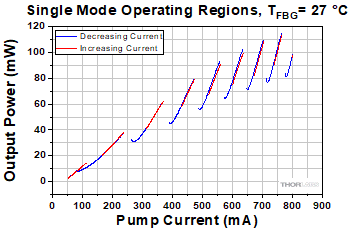 Click to Enlarge
Click to EnlargeClick for Data
This graph shows the typical single mode operating regions for a ULN15TK laser system operated at a fiber Bragg grating temperature (TFBG) of 27 °C. Multimode regions have been removed.
- 100 Hz Typical Lorentzian Linewidth
- -160 dBc/Hz Typical Relative Intensity Noise (RIN)
- 70 dB Typical Side-Mode Suppression Ratio (SMSR)
- 120 mW Typical Output Power
Thorlabs' ULN15TK Turnkey, Ultra-Low-Noise (ULN) Laser System is a ready-to-use laser system that integrates our ULN15PC laser, which has a patented fiber Bragg grating (FBG) based design, with a low-noise driver and temperature stabilization inside of a benchtop housing. The temperature of the laser case is stabilized through a third temperature stabilization circuit to provide long-term power and wavelength stability when the system is used in standard laboratory environments. See the blue info icon (![]() ) in the table below for typical performance specifications. Specific wavelengths within the center wavelength range, including 1560 nm for frequency doubling to access rubidium transitions, are available upon request.
) in the table below for typical performance specifications. Specific wavelengths within the center wavelength range, including 1560 nm for frequency doubling to access rubidium transitions, are available upon request.
The ULN15TK laser system provides exceptionally narrow Lorentzian linewidth (typ. 100 Hz) and record low RIN (typ. -160 dBc/Hz) for applications that require demanding noise performance. The ULN design is based on a hybrid external-cavity semiconductor laser employing a fiber Bragg grating (FBG) for feedback to the laser cavity. As a result, the mode-hop-free single-frequency regions of the ULN are not continuous as the laser current is adjusted. Each mode-hop-free single-frequency region is typically limited to 20 mA to 50 mA of drive current (see Graphs tab). The ULN wavelength can be adjusted via both current adjustment of the chip and temperature adjustment of the FBG. In order to maintain single-frequency operation as the temperature is tuned over a broad range, the laser current needs to be adjusted simultaneously.
The system comes equipped with two analog current modulation ports (AC and DC coupled) and an analog temperature modulation port, which can be used to lock the laser frequency to optical cavities or reference using servo electronics in order to build stable laser systems. Remote operation is possible by connecting the laser to a PC and using a command line interface.
The optical output of this laser is fiber-coupled via an FC/APC bulkhead (2.0 mm narrow key) output connector. For best performance, we recommend connecting our PM FC/APC fiber patch cables that contain PM1550-XP fiber. Each laser is shipped with a DS12 power supply; see the Shipping List tab for a complete list of items included with the device.
Specific wavelengths within the center wavelength range, including 1542 nm and 1560 nm, are available upon request. Please contact Tech Sales for more information.

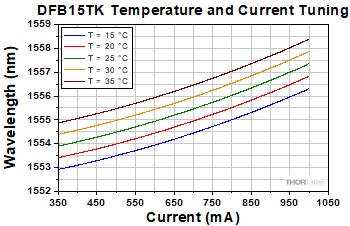
Click to Enlarge
Click Here for Data
Example temperature and current tuning for a DFB15TK laser system operated at the factory-set conditions.
- 50 kHz Typical Lorentzian Linewidth
- -150 dBc/Hz Typical Relative Intensity Noise (RIN)
- Continuous Mode-Hop-Free Single Frequency Operation
- 2 nm Temperature Tuning Range
Thorlabs' DFB15TK Turnkey, Low-Noise Distributed Feedback (DFB) Laser System is a ready-to-use laser system that integrates our DFB1550P with a low-noise driver and temperature stabilization inside of a benchtop housing. See the blue info icon (![]() ) in the table below for typical performance specifications. Each DFB laser system is serialized and ships with individual test data; click here for a sample data sheet. Customers can click "Choose Item" below to view a variety of available center wavelengths.
) in the table below for typical performance specifications. Each DFB laser system is serialized and ships with individual test data; click here for a sample data sheet. Customers can click "Choose Item" below to view a variety of available center wavelengths.
The DFB design allows a broad mode-hop-free single-frequency operation region (350 mA to 1000 mA), while maintaining a narrow 50 kHz Lorentzian linewidth and a typical relative intensity noise (RIN) of -150 dBc/Hz. Wavelength tuning can be accomplished by adjusting the current or the temperature of the laser chip, with typical temperature tuning of up to 2 nm (with the chip temperature adjusted by 20 °C). The DFB15TK will remain single-frequency as the temperature is tuned without the need to simultaneously adjust the current.
The system comes equipped with two analog current modulation ports (AC and DC coupled) and an analog temperature modulation port, which can be used to lock the laser frequency to optical cavities or reference using servo electronics in order to build stable laser systems. Remote operation is possible by connecting the laser to a PC and using a command line interface.
The optical output of this laser is fiber-coupled via an FC/APC bulkhead (2.0 mm narrow key) output connector. For best performance, we recommend connecting our PM FC/APC fiber patch cables that contain PM1550-XP fiber. Each laser is shipped with a DS12 power supply; see the Shipping List tab for a complete list of items included with the device.
 Products Home
Products Home














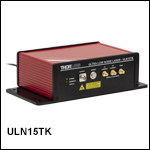
 ズーム
ズーム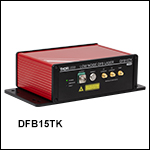
 1550 nm狭線幅単一周波数レーザ
1550 nm狭線幅単一周波数レーザ